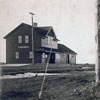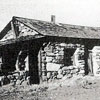Foremost and Walsh
 With a population of 524, Foremost is situated 106 kilometres southwest of Medicine Hat. The Estonian pioneers who settled in the Foremost area arrived in Alberta via South Dakota. Hans Maar (Meer) and his family purchased a homestead approximately 85 kilometres northeast of the town of Warner in 1907. By 1910, seven more Estonian homesteads emerged in the area.
With a population of 524, Foremost is situated 106 kilometres southwest of Medicine Hat. The Estonian pioneers who settled in the Foremost area arrived in Alberta via South Dakota. Hans Maar (Meer) and his family purchased a homestead approximately 85 kilometres northeast of the town of Warner in 1907. By 1910, seven more Estonian homesteads emerged in the area.
Prior to irrigation and paved highways, the area surrounding Foremost was a difficult place to start a farm. Isolated, Estonian families relied on each other and hard work to make a living. For instance, The Krasman family arrived here in 1909 while their closest neighbour was over 40 kilometres away. Life on the prairie was a difficult adjustment for newly-arriving Estonians. For the Krasmans a monthly trip to the nearest town was a two-day affair. The nearest doctor was a full day journey. Strong winds wreaked havoc on poorly constructed homes; the Krasmans observed its mighty power when their barn roof was torn to shreds in one particular wind storm. The nearest school was eight kilometres away and because of the sheer distance many Estonian children did not attend on a consistent basis.
 Estonian pioneers farming in the semi-arid climate of southern Alberta often experienced severe drought. Before the introduction of irrigation, entire crops were often destroyed by drought. Isolation and the paucity of water were key contributing factors to the gradual decrease in the Estonian population.
Estonian pioneers farming in the semi-arid climate of southern Alberta often experienced severe drought. Before the introduction of irrigation, entire crops were often destroyed by drought. Isolation and the paucity of water were key contributing factors to the gradual decrease in the Estonian population.
Walsh, Alberta is located 57 kilometres east of Medicine Hat, located on the Trans Canada Highway. Situated north of the Cypress Hills, Walsh is well-known locally for its lively auction centre specializing in the sale of livestock.
There is little known about the first Estonians who settled in the area around Walsh. Arriving in 1904, J. Smith (it is assumed Mr. Smith changed his name at some point prior to arriving in southern Alberta) settled in the rolling hills having traveled from as far away as Russia. In total, there were twelve Estonian families living in the Walsh area including the Fridulins, Jurkin, Orman, Tihkane, Witser, Bulow, Eringson and Juhanson. Given the conditions of the time, successful farming was extremely challenging; therefore, men often earned an income working on the railroad. They would earn upwards of $1.50 per ten-hour shift. Similar to Foremost, Estonian families living near Walsh soon migrated towards Alberta's urban centres in search of better employment opportunities.
Additional information can be found in History - Alberta Estonian Settlements - Warner and Foremost or History - Alberta Estonian Settlements - Walsh








